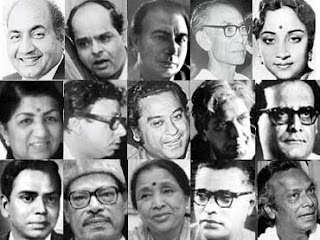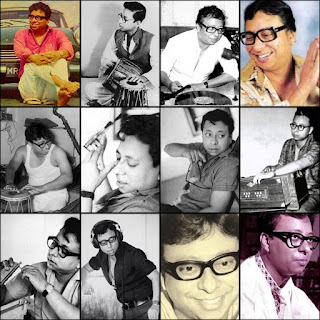PART 5 OF 10: JUNGLE MEIN MOR NACHA KISNE DEKHA HAI? (DON'T ANSWER THAT. IT'S A RHETORICAL QUESTION)
I think this series has gotten way too intense. Time to lighten things up a bit.
Seeing the rather morose settings and the long faces from previous songs, one may infer that the Bombay film industry did not possess a musical funny bone. That cannot be further from the truth. The stalwarts of the yore had enough musical sagacity to compose lighter numbers along the way, and keep the audience in raptures. And the audience of that era deserved every bit of rapture that one could give.
Imagine India of that period, just around the time it became a republic and adopted the new constitution authored by Dr Ambedkar. The wounds from partition and Gandhi's assassination were still raw. Nehru and Patel were at the helm of a nascent, unstable democracy, whose survival was in doubt. The social indicators were pathetic. Literacy rate was eighteen percent, life expectancy was thirty-one years, and nearly half the country was below the poverty line. India seemed to be facing a perpetual grain shortage and we were growing at two percent a year. So, those that argue that the British brought progress and prosperity during their two-hundred years of imperial rule can go take a hike. 1950-75 may have been the Golden Age for the Hindi film industry. It was anything but that for India, in general. Not on any conceivable dimension. People were not jumping up and down deliriously playing karwa chauth in designer costumes, like you see in Sooraj Barjatya movies. So, the film industry's contribution toward loosening up things and bringing a smile on people's faces cannot be understated.
As far as music goes, the Grand Old Man of Indian music, C. Ramachandra, had laid the early foundation with songs such as 'Sunday ke sunday', 'Ina Mina Dika' and the like. SD Burman had 'Sar jo tera chakraye' and 'Main sitaron ka taraana', OP Nayyar had 'Ae dil hai mushkil', and almost every song with the Shammi-Rafi combo.
But there was no bigger mascot for this genre of filmmaking and music than the legendary Kishore Kumar. Kishoreda was the undisputed king of comedy of this era. 'Chalti Ka Naam Gaadi', 'Half Ticket', 'Jhumroo', 'Dilli Ka Thug', 'Mr X in Bombay'…I could go on and on. The songs in these movies were veritable gems. What makes them memorable to this day is what Kishore did with them. He infused his no-holds-barred style of acting and fun-making, yodeling and voice acting, and all his raw energy, to light(en) up the screens. Kishoreda was totally in his zone. If he had not evolved into the playback singing god after the late-sixties, he would have gone down in the annals of film history as the king of comic acting.
But hold your breath. The song I am going to feature here is not from Kishoreda. It is Rafi again. (Yeah, all that build up for Kishoreda was for nothing). And the reason I chose this over 'Paanch rupiah barah anah', 'Haal kaisa hai janaab ka', 'Cheel cheel chillake', and the bevy of Kishore hits from this time is because of Salil Chowdhury – the Maestro from Bengal.
Salilda's childhood was spent in the Tea gardens of Bengal, bordering Assam. By his early teens, he was already adept at playing the piano, flute, harmonium, and esraj. The western classical music that his dad played on his gramophone and the folk music that he heard from the surrounding villages deeply influenced and shaped his musical signature. In his early twenties, Salilda became an active member of the communist movement and the Indian Peoples Theater Association (IPTA). What is it about famous artistes of that era and their love affair with Communism? Was it a fad? Or was it their inherent sense of "fairness" and equality (and its implied connection with Communism, as dubious as it may seem to some, today)?
Salilda debuted as a music composer for the Bengali movie 'Paribortan'. But his real break came from his association with Bimal Roy. Salilda penned the story and scored the music for 'Do Bigha Zameen' (1953), his debut in Hindi. Within a few years, his name came to be associated with among the best music directors in India. He produced musical gold, whether it was in Bengali, Hindi, Kannada, or Malayalam: 'Jagte Raho', 'Madhumati', 'Chemeen', 'Anand', 'Chhoti si baat', 'Kokila', 'Doorathu idi muzhakkam'...the list was long. By the time he passed away in 1995, he had composed for over a hundred movies in thirteen languages.
Salilda's signature was his Jazz and Blues style. But I would be doing a huge disservice to him if I pigeon-hole him into any one genre, for he was extremely versatile. No other work of his proves that point better than 'Madhumati' – the number one movie of 1958, featuring Dilip Kumar and Vyjayanthi Mala.
Kisi ko suit boot coat ka nasha hai.
Yaaron hume to nau taank ka nasha hai
Hum jo thodi si pi ke zara jhume haay re sab ne dekha
For a better version of the video, click the link below:








Comments
Post a Comment